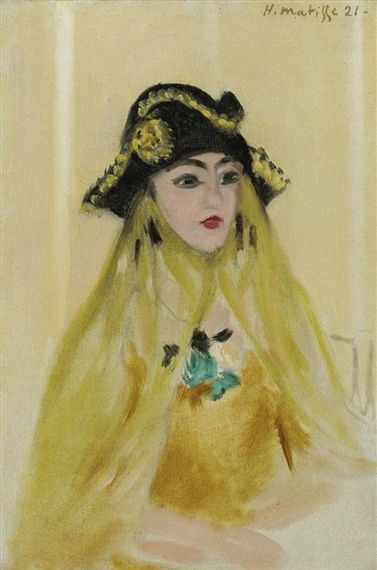Description
Henri Matisse, a monumental figure in 20th-century art, is known for his innovative use of color and his distinctive style that challenged prevailing artistic conventions. Throughout his artistic journey, Matisse explored different styles and techniques that left an indelible mark on the history of art. "Venetian Woman En Buste" from 1921 is a work that encapsulates the artist's mastery in handling color and form.
In this painting, Matisse presents us with the bust of a woman whose features exude elegance and mystery. The figure dominates the canvas with a calm but imposing presence. Her eyes are slightly narrowed, suggesting an introspection that invites the viewer to a deeper contemplation. A predominantly warm color palette is observed, with shades of yellow, orange, and red combining to highlight the vibrancy of the central character.
The choice of color is crucial in this work, as in many of Matisse's compositions. The warm tones not only bring the figure to life but also create a visual harmony that is both attractive and serene. This harmony is reinforced by the simplification of forms and the softness of the lines that outline the figure. The use of color and form reflects Matisse's interest in simplification and essence, moving away from detailed realism to capture a deeper and more subjective truth.
It is worth noting that the influence of Fauvism, of which Matisse was one of the leaders, is palpable in "Venetian Woman En Buste." This movement, characterized by its experimental use of color and its rejection of traditional perspective, is at the foundation of this portrait. Matisse employs flat colors and defined contours to create a composition where color is the protagonist, not just an accompaniment to the drawing.
Despite the apparent simplicity of the work, each brushstroke reflects the artist's meticulous consideration for balance and cohesion. The asymmetrical arrangement of the portrait, with the figure slightly shifted to one side, adds dynamism to the composition without destabilizing it. This asymmetry, combined with the vibrancy of the colors, imbues the painting with a contained energy and an almost imperceptible sense of movement.
The historical context in which this work was created is also significant. By the 1920s, Matisse had already consolidated his style, moving away from initial Impressionist influences towards a more personal and authentic voice. "Venetian Woman En Buste" is a testament to this artistic development, showcasing a mastery of color and form in its highest expression.
Compared to other works by Matisse, this painting shares the simplicity and focus on the essence of the subject that characterize his later portraits. Works like "La Blusa Rumana" from 1940 also reflect this focus on simplification and bold use of color, despite differences in context and execution.
"Venetian Woman En Buste" is, without a doubt, a work that exemplifies Henri Matisse's mastery in his ability to transform the simple into the sublime through his innovative use of color and form. Every element of the painting, from the choice of colors to the composition and the figure, comes together to create a work that not only defines an era in modern art but also continues to resonate with power and beauty in the present.

